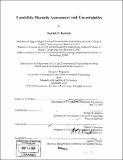| dc.contributor.advisor | Herbert H. Einstein and Daniele Veneziano. | en_US |
| dc.contributor.author | Karam, Karim S. (Karim Semaan), 1977- | en_US |
| dc.contributor.other | Massachusetts Institute of Technology. Dept. of Civil and Environmental Engineering. | en_US |
| dc.date.accessioned | 2006-07-31T15:24:01Z | |
| dc.date.available | 2006-07-31T15:24:01Z | |
| dc.date.copyright | 2005 | en_US |
| dc.date.issued | 2005 | en_US |
| dc.identifier.uri | http://hdl.handle.net/1721.1/33690 | |
| dc.description | Thesis (Ph. D.)--Massachusetts Institute of Technology, Dept. of Civil and Environmental Engineering, 2005. | en_US |
| dc.description | Includes bibliographical references (v. 2, p. 736-750). | en_US |
| dc.description.abstract | Landslides are natural phenomena which are difficult to predict because their initiation depends on many factors and on the interaction between these factors. The annual number of causalities caused by landslides is in the thousands, and infrastructural damage is in the billions of dollars. To satisfy the increasingly urgent societal demand for protection against landslides, it is necessary to systematically assess and manage landslide hazard and risk. This can be done using principles of decision making under uncertainty. We develop an advanced combined hydrologic - stability model that is better capable of assessing landslide hazards than current models used in landslide analyses. This model allows one to evaluate landslide hazards deterministically. We use the model to study landslide failure mechanisms, and classify these according to the manner in which a slope gets saturated during rain. We showed that slopes with great depths to bedrock and shallow depths to the water table, tend to fail by saturation from below, resulting in deep seated landslides, and slopes with deep lying water tables tend to fail by saturation from above, resulting in shallow landslides. | en_US |
| dc.description.abstract | (cont) Landslide hazards include, by definition, uncertainties which can be expressed probabilistically. Uncertainties arise from parameters and from models. We develop efficient techniques to formally incorporate parameter uncertainties into the combined hydrologic - stability model, and hence into the hazard assessment procedure. We then show that landslide hazards are significantly influenced by the joint probability distribution of the soil strength parameters and the strength submodel(s) used in the stability models, and by the soil characteristic curve submodel(s) used in the hydrologic models. This study leads to a better understanding of landslide mechanisms and to advanced models that assess landslide hazards more accurately than current models. The results of parameter uncertainty investigations show which parameters are most important in landslide analyses, and hence where it is worthwhile to obtain more information. The results of model uncertainty investigations show which models are most important in landslide analyses, and hence where further research needs to be undertaken. | en_US |
| dc.description.statementofresponsibility | by Karim S. Karam. | en_US |
| dc.format.extent | 2 v. (750 p.) | en_US |
| dc.format.extent | 34981643 bytes | |
| dc.format.extent | 35014786 bytes | |
| dc.format.mimetype | application/pdf | |
| dc.format.mimetype | application/pdf | |
| dc.language.iso | eng | en_US |
| dc.publisher | Massachusetts Institute of Technology | en_US |
| dc.rights | M.I.T. theses are protected by copyright. They may be viewed from this source for any purpose, but reproduction or distribution in any format is prohibited without written permission. See provided URL for inquiries about permission. | en_US |
| dc.rights.uri | http://dspace.mit.edu/handle/1721.1/7582 | |
| dc.subject | Civil and Environmental Engineering. | en_US |
| dc.title | Landslide hazards assessment and uncertainties | en_US |
| dc.type | Thesis | en_US |
| dc.description.degree | Ph.D. | en_US |
| dc.contributor.department | Massachusetts Institute of Technology. Department of Civil and Environmental Engineering | |
| dc.identifier.oclc | 64636690 | en_US |
